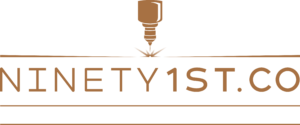Free plans to DIY a farmhouse table with store-bought table legs.
DIMENSIONS
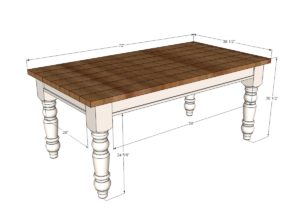
Dimensions are shown above.
PREPARATION
- 4 – Osborne Wood Husky Dining Table Legs
- 2 – 2×4 @ 8 feet long
- 2 – 1×2 @ 8 feet long
- 7 – 2×6 @ 72″ long (you may consider using 2×6 tongue and groove for an easier finishing option but as shown in photos, I used 2x6s Kreg jigged together and then sanded flat on top with a belt sander)
- 2 1/2″ pocket hole screws
- 2″ finish nails
- wood glue
- 2 – 2×4 @ 58″ (side aprons)
- 2 – 2×4 @ 26″ (end aprons)
- 2 – 1×2 @ 26″ (end apron trim)
- 2 – 1×2 @ 58″ (side apron trim)
- 7 – 2×6 @ 72″ (tabletop boards)
INSTRUCTION
STEP 1
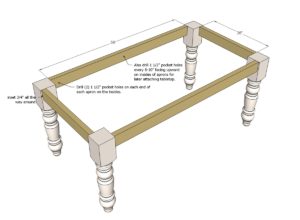
First things first, drill all the pocket holes in the aprons. You’ll need two per apron end, and then ever 8″ or so, a 1 1/2″ pocket hole facing upward for attaching the tabletop later on.
When you go to attach the legs to the aprons, make sure you have the pocket holes pointing upward – I make this mistake all the time – doh! – but you are probably way smarter than me!.
STEP 2
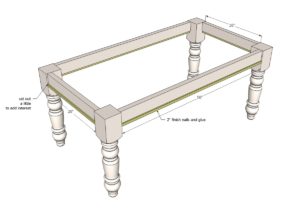
This is really just to add that decorative touch to the underside.
Another option for those of you with a table saw is to use 2x6s for the aprons and then cut a small groove with the table saw at the base of the aprons to give the look of multiple boards.
NOTE: You can also add corner cross supports, but we found the table really didn’t need it. It’s up to you!.
STEP 3
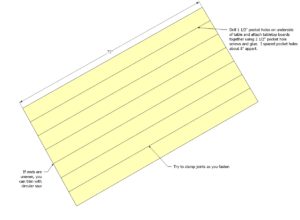
Now build the top. If I can say anything about this top it’s this: GET STRAIGHT BOARDS. Mine was a little crooked and so I ended up having to use long bar clamps to pull everything together tight as I attached pocket holes.
Clamp, clamp, and clamp!
If your ends end up a little off, no biggie there, just run a circular saw down the ends to clean them up.
I think part of this table’s charm is the planked top, but to make it more functional, we belt sanded the top flat, and then silicone any gaps to prevent food from sticking in cracks.
Not trying to scare you – this wasn’t hard – it’s just my sister’s got kids between 6 months and 9, and we are preparing this table for real-life use and abuse.
STEP 4
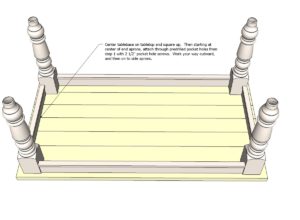
Now flip the tabletop over so all the pocket holes are facing up and place the base on it. Then just start attaching through those predrilled pocket holes into the tabletop.
Flip it over (it’s gonna be heavy!) and the building part is done!.
FINISHING INSTRUCTIONS
Fill all holes with wood filler and let dry. Apply additional coats of wood filler as needed. When wood filler is completely dry, sand the project in the direction of the wood grain with 120 grit sandpaper. Vacuum sanded project to remove sanding residue. Remove all sanding residue on work surfaces as well. Wipe project clean with a damp cloth.
It is always recommended to apply a test coat on a hidden area or scrap piece to ensure color evenness and adhesion. Use primer or wood conditioner as needed.
CREDIT ANA WHITE
